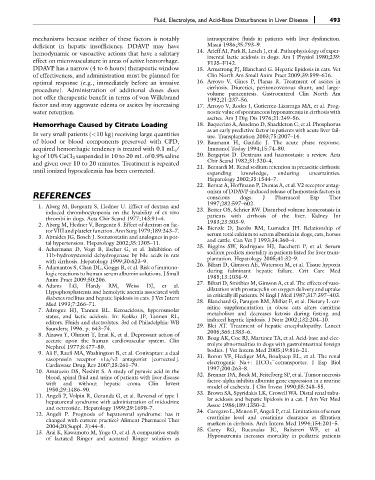Page 505 - Fluid, Electrolyte, and Acid-Base Disorders in Small Animal Practice
P. 505
Fluid, Electrolyte, and Acid-Base Disturbances in Liver Disease 493
mechanisms because neither of these factors is notably intraoperative fluids in patients with liver dysfunction.
deficient in hepatic insufficiency. DDAVP may have Masui 1986;35:793–9.
hemodynamic or vasoactive actions that have a salutary 14. Arieff AI, Park R, Leach J, et al. Pathophysiology of exper-
imental lactic acidosis in dogs. Am J Physiol 1980;239:
effect on microvasculature in areas of active hemorrhage.
F135–F142.
DDAVP has a narrow (4 to 6 hours) therapeutic window 15. Armstrong PJ, Blanchard G. Hepatic lipidosis in cats. Vet
of effectiveness, and administration must be planned for Clin North Am Small Anim Pract 2009;39:599–616.
optimal response (e.g., immediately before an invasive 16. Arroyo V, Gines P, Planas R. Treatment of ascites in
cirrhosis. Diuretics, peritoneovenous shunt, and large-
procedure). Administration of additional doses does
volume paracentesis. Gastroenterol Clin North Am
not offer therapeutic benefit in terms of von Willebrand
1992;21:237–56.
factor and may aggravate edema or ascites by increasing 17. Arroyo V, Rodes J, Gutierrez-Lizarraga MA, et al. Prog-
water retention. nostic value of spontaneous hyponatremia in cirrhosis with
ascites. Am J Dig Dis 1976;21:249–56.
Hemorrhage Caused by Citrate Loading 18. Baquerizo A, Anselmo D, Shackleton C, et al. Phosphorus
as an early predictive factor in patients with acute liver fail-
In very small patients (<10 kg) receiving large quantities ure. Transplantation 2003;75:2007–14.
of blood or blood components preserved with CPD, 19. Baumann H, Gauldie J. The acute phase response.
acquired hemorrhagic tendency is treated with 0.1 mL/ Immunol Today 1994;15:74–80.
kg of 10% CaCl 2 suspended in 10 to 20 mL of 0.9% saline 20. Bergqvist D. Dextrans and haemostasis: a review. Acta
Chir Scand 1982;31:320–4.
and given over 10 to 20 minutes. Treatment is repeated
21. Bernardi M. Renal sodium retention in preascitic cirrhosis:
until ionized hypocalcemia has been corrected. expanding knowledge, enduring uncertainties.
Hepatology 2002;35:1544–7.
22. Bernat A, Hoffmann P, Dumas A, et al. V2 receptor antag-
REFERENCES onism of DDAVP-induced release of hemostasis factors in
conscious
Exp
dogs.
Pharmacol
J
Ther
1997;282:597–602.
1. Aberg M, Bergentz S, Hedner U. Effect of dextran and 23. Better OS, Schrier RW. Disturbed volume homeostasis in
induced thrombocytopenia on the lysability of ex vivo
thrombi in dogs. Acta Chir Scand 1977;143:91–4. patients with cirrhosis of the liver. Kidney Int
2. Aberg M, Hedner V, Bergentz S. Effect of dextran on fac- 1983;23:303–9.
tor VIII and platelet function. Ann Surg 1979;189:243–7. 24. Bienzle D, Jacobs RM, Lumsden JH. Relationship of
3. Abraldes JG, Bosch J. Somatostatin and analogues in por- serum total calcium to serum albumin in dogs, cats, horses
tal hypertension. Hepatology 2002;35:1305–11. and cattle. Can Vet J 1993;34:360–4.
4. Ackermann D, Vogt B, Escher G, et al. Inhibition of 25. Biggins SW, Rodriguez HJ, Bacchetti P, et al. Serum
11b-hydroxysteroid dehydrogenase by bile acids in rats sodium predicts mortality in patients listed for liver trans-
with cirrhosis. Hepatology 1999;30:623–9. plantation. Hepatology 2005;41:32–9.
5. Adamantos S, Chan DL, Goggs R, et al. Risk of immuno- 26. Bihari D, Gimson AE, Waterson M, et al. Tissue hypoxia
logic reactions to human serum albumin solutions. J Small during fulminant hepatic failure. Crit Care Med
Anim Pract 2009;50:206. 1985;13:1034–9.
6. Adams LG, Hardy RM, Weiss DJ, et al. 27. Bihari D, Smithies M, Gimson A, et al. The effects of vaso-
dilatation with prostacyclin on oxygen delivery and uptake
Hypophosphatemia and hemolytic anemia associated with in critically ill patients. N Engl J Med 1987;317:397–403.
diabetes mellitus and hepatic lipidosis in cats. J Vet Intern 28. Blanchard G, Paragon BM, Milliat F, et al. Dietary L-car-
Med 1993;7:266–71.
7. Adrogue HJ, Tannen RL. Ketoacidosis, hyperosmolar nitine supplementation in obese cats alters carnitine
metabolism and decreases ketosis during fasting and
states, and lactic acidosis. In: Kokko JP, Tannen RL, induced hepatic lipidosis. J Nutr 2002;132:204–10.
editors. Fluids and electrolytes. 3rd ed Philadelphia: WB 29. Blei AT. Treatment of hepatic encephalopathy. Lancet
Saunders; 1996. p. 643–74.
2005;365:1383–6.
8. Aizawa Y, Ohmori T, Imai K, et al. Depressant action of 30. Boag AK, Coe RJ, Martinez TA, et al. Acid-base and elec-
acetate upon the human cardiovascular system. Clin trolyte abnormalities in dogs with gastrointestinal foreign
Nephrol 1977;8:477–80.
bodies. J Vet Intern Med 2005;19:816–21.
9. Ali F, Raufi MA, Washington B, et al. Conivaptan: a dual 31. Boron VF, Hediger MA, Boulpaep EL, et al. The renal
vasopressin receptor v1a/v2 antagonist [corrected]. electrogenic Naþ: HCO 3 cotransporter. J Exp Biol
Cardiovasc Drug Rev 2007;25:261–79.
10. Amatuzio DS, Nesbitt S. A study of pyruvic acid in the 1997;200:263–8.
blood, spinal fluid and urine of patients with liver disease 32. Brenner DA, Buck M, Feitelberg SP, et al. Tumor necrosis
with and without hepatic coma. Clin Invest factor-alpha inhibits albumin gene expression in a murine
1950;29:1486–90. model of cachexia. J Clin Invest 1990;85:248–55.
11. Angeli P, Volpin R, Gerunda G, et al. Reversal of type 1 33. Brown SA, Spyridakis LK, Crowell WA. Distal renal tubu-
hepatorenal syndrome with administration of midodrine lar acidosis and hepatic lipidosis in a cat. J Am Vet Med
and octreotide. Hepatology 1999;29:1690–7. Assoc 1986;189:1350–2.
12. Angeli P. Prognosis of hepatorenal syndrome: has it 34. Caregaro L, Menon F, Angeli P, et al. Limitations of serum
changed with current practice? Aliment Pharmacol Ther creatinine level and creatinine clearance as filtration
2004;20(Suppl. 3):44–8. markers in cirrhosis. Arch Intern Med 1994;154:201–5.
13. Arai K, Kawamoto M, Yuge O, et al. A comparative study 35. Carey RG, Bucuvalas JC, Balistreri WF, et al.
of lactated Ringer and acetated Ringer solution as Hyponatremia increases mortality in pediatric patients

